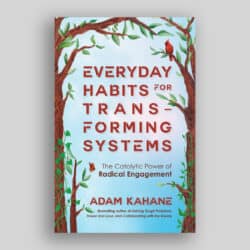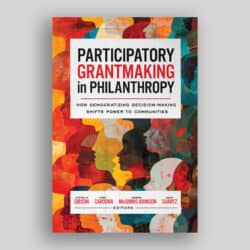Five Good Ideas—Practical Strategies For Non-profit Success
Edited by Alan Broadbent & Ratna Omidvar
Toronto: Coach House Press; 2011 isbn: 978-1-55245-246-2
At first glance of the cover of Five Good Ideas—Practical Strategies for Non- Profit Success, readers may conclude that the focus of the book is limited to five important areas for consideration in the non-profit world and guidance on how to work through those areas. Readers will be pleasantly surprised to find that this book provides over 90 great ideas, throughout 38 sub-topic articles on seven broad topic areas. While not every chapter may be relevant to all organizations, the book is written to easily navigate to the topic area most critical to an organization at any given time. There is no right way to read the book; for general knowledge the reader can start at the beginning and read through each of the chapters consecutively, or concentrate on the topic that best aligns with the current issue at hand.
As mentioned, Five Good Ideas focuses on seven broad topic area chapters: Leadership and Vision, Organizational Effectiveness, Human Resources, Resource Development, Communications, Advocacy, and Policy & Governance. Each chapter is further broken down into sub-topic areas that have been identified as the most critical to effectively manage a non-profit organization.
One of the strengths of this book is that it was not authored by one individual claiming to be an expert in all areas of the non-profit sector, but rather by real experts in each of the areas covered. The expertise of the authors is demonstrated throughout the book. Each author’s personal experience in their respective areas makes the articles, almost always, instantly credible. However, this also highlights a gap; young non-profit organizations would have benefited from a summary or road map on how best to navigate the many topic areas.
Five Good Ideas is the brainchild of editors Alan Broadbent and Ratna Omidvar as a way of sharing relevant, timely information in a form other than the normal, sometimes time-consuming conference. Mr. Broadbent is the Chair of Maytree and Ms. Omidvar is Maytree’s President. Maytree is a private Canadian foundation established in 1982. While Maytree has a broad mandate to reduce poverty and inequality in Canada, they are heavily focused on the sharing of resources that will help non-profit organizations find success, whatever the particular direction of their work. What started as regular lunch and learnings through Maytree, to offer participants insights gleaned from practical experience, has now emerged as every non-profit’s “must have” textbook.
Whether your group is a small or large non-profit organization, Five Good Ideas will provide guidance to employees who wear multiple hats within their organization. It can serve as a go-to reference to provide leadership suggestions, another perspective to assess whether their organization is on the right track, or ideas that perhaps were not identified earlier. A short summary follows of five key articles.
“Strategic Planning” by James Appleyard. The difference between effective strategic planning and ineffective strategic planning often comes down to the preparation before the planning even begins. As Mr. Appleyard points out, it is imperative that organizations give thought to who should participate in the process (with a broader group being more impactful than an exclusive group), and to how the organization will ensure the strategic planning process is as effective as possible. The preparation work should include (1) a discussion on what the organization can do best; (2) how they will align their existing core values to social needs and priorities; (3) a decision on which outcomes will be measured against (for future tracking); (4) a decision on the priorities most important at the time of the plan (you can’t do it all); and (5) ensuring internal consistency to deliver better outcomes.
Mr. Appleyard states that, based on the strength of their leaders or their current success, not all organizations may need a strategic plan. However, it is difficult to imagine that anyone would disagree that there is always value in documenting — even at a high level— the goals of the organization and the plan to get there. Planning, even at the most simplistic level will ensure buy-in and commitment from all stakeholders, and mitigates against knowledge or culture loss through the regular cycle of succession.
“Leading an Inclusive Organization” by Kay Blair. Many organizations may state that they lead an inclusive organization. Unfortunately, few put it into day-to-day practice. As Ms. Blair points out, “inclusive leadership is the ability to step back and engage and empower others in your organization” (Blair, 2011 p. 46). To do this takes time and patience — organizations need not be in a rush to meet their goals but need to be thoughtful and reflective. To move your organization down this path, you need to (1) think of leadership as an action, not a position; (2) invest in the talent of your organization; (3) support and encourage self-directed teams within your organization; (4) make inclusiveness part of your organization’s DNA; and (5) embrace diversity.
“Improving Employment Relations” by Dave McKechnie. Improving employee relations is not a final destination but rather a journey that never ends. This is one of the longer chapters in the book, as it should be. Having strong employee relations will keep your organization strong and healthy. The author guides the reader through his five ideas to keep employee relations at the core of all organizations: (1) Communicate always — begin when an employee joins your organization and keep communicating continuously; (2) walk the floor; (3) encourage constant chatter and reinforcement; (4) implement meaningful recognition; and (5) listen, investigate, and respond.
Leadership is often demonstrated not when the organization or employee relations are at their best, but rather when issues and challenges arise. Managers need to embrace difficult situations — not shy away. If effective communication is at the heart of your organization, the number of difficult situations will be minimized.
“Corporate Fundraising” by Susan McIsaac. Competition for donor dollars is fierce and donors are becoming far more critical as they make their donation decisions. It’s not enough to just ask for a donation—you need to make a connection. Making, or not making, that connection will define your fundraising success. To increase your odds for success, Ms. McIsaac suggests focusing on (1) developing a strong, clear value proposition; (2) understanding corporate partners; (3) building support within the company; (4) aiming for employee funds; and (5) developing meaningful recognition and stewardship.
“Board Governance” by Tom Williams. Having strong Board Governance can be the difference between an effective organization and an ineffective organization. The importance of good governance cannot be overstated but is often overlooked. Mr. Williams highlights five working principles that will ensure your organization will have a strong governance structure in place. He suggests that an organization should (1) acknowledge that good governance is always a work in progress; (2) recognize that good governance is proactive, strategic, and embraces accountability; (3) manage conflicts of interest early; (4) develop leadership and plan for succession; and (5) engage their board members meaningfully.
Imagine Canada recently launched a new Standards program that offers a Canada-wide set of shared standards for charities and non-profits. In many ways, Five Good Ideas reinforces the standards that Imagine Canada has identified as being core to non-profit organizations — effectiveness in the fundamentals of governance, paid-staff management, financial accountability, fundraising, and volunteer involvement.
In addition to the wealth of information provided by experts in each of the chapter topic areas, every chapter also includes Five Good Resources to further the reader’s learning. Five Good Ideas should be in every non-profits’ library, if for no other reason than the reality that all of our success is dependent on learning from each other and from sharing our knowledge. As we all adopt this way of thinking we strengthen the entire sector as a whole.
Sue Tardi is Vice President, Internal Relations and Operations with United Way of Winnipeg. United Way of Winnipeg is a nonprofit organization whose focus is to create opportunities for a better life for everyone. Email: stardi@ unitedwaywinnipeg.mb.ca .


